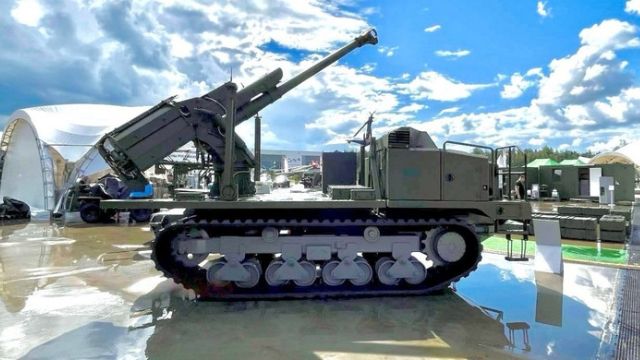En la Exposición ARMY 2024, la Federación Rusa presentó su última innovación en el área de las armas robóticas, que se incorpora a la categoría de los UGCV (Unmanned Ground Combat Vehícle) de ese país. Denominado MTS-15 “Detelina” (Clover), consiste en un Obús Autopropulsado de Artillería (SPH), robótico y equipado con un Obús D-30 de calibre 122mm, arma en servicio desde hace décadas en las FFAA rusas y suficientemente probado en combate. Este sistema semiautónomo, puede ser operado por un solo hombre desde una distancia de 500m y tiene una autonomía superior a los 120km. Dispone de un sistema automático de carga “tipo revolver” con 4 proyectiles, que permite al arma tomar posición y ejecutar el fuego en 30 seg. Según la agencia de prensa TASS, próximamente el MTS- 15 sería enviado al frente de batalla para evaluaciones en condiciones de combate real.
At the Army-2024 military forum, the Russian Federation showcased its latest innovation: the 122mm unmanned ground self-propelled howitzer, known as the MTS-15 Detelina [Clover]. According to a source from the Russian news agency TASS, the MTS-15 is slated for deployment to the Northern Military District for combat testing soon. Should these reports be verified, it marks the potential introduction of the first unmanned artillery system in Ukraine.
Specifically designed to neutralize and overpower enemy forces, the MTS-15 is essentially a D-30 howitzer integrated into a remotely operated robotic platform. Only one operator is required to command the system, and they can do so from as far as half a kilometer away.
“The prototype has already been tested under controlled conditions. It will soon be dispatched to the Northern Military District for further testing,” TASS quoted the source.

PTS-15 and D-30
Currently, information about the technical characteristics of the MTS-15 Detelina remains limited. The military resource Top War mentions that this self-propelled gun can travel up to 12 km/h. There’s some discrepancy about its range; Top War mentions 400 km, while other sources suggest it’s 120 km. Notably, the Detelina is equipped with a four-round autoloader and shares many specifications with the D-30 howitzer, including the ability to transition into and out of the battle position in just 30 seconds.
The D-30 howitzer is a 122mm towed artillery piece developed by the Soviets and widely used since its debut in the 1960s. Operating the D-30 involves several critical steps: preparing the gun, calculating the firing data, loading the ammunition, aiming with sighting equipment, and finally, firing the round.

This versatile howitzer can utilize various ammunition types, each designed for different purposes. High-explosive [HE] shells are commonly used for general bombardment. Armor-piercing [AP] rounds are intended for targeting armored vehicles, while illumination rounds light up the battlefield. Additionally, smoke rounds are used to obscure visibility, and chemical rounds deliver chemical agents.
Competitors
In the United States, the army has been exploring the potential of unmanned artillery systems. One notable project is the Autonomous Multi-Domain Launcher [AML], which aims to integrate autonomous capabilities into existing artillery platforms. South Korea is another country investing in unmanned artillery technology. Hanwha Defense, a major defense contractor, has been working on the K9 Thunder self-propelled howitzer.

In Europe, the German defense industry is exploring the integration of autonomous technologies into the PzH 2000, one of the most advanced self-propelled howitzers in the world. China, known for its rapid advancements in military technology, is also developing unmanned self-propelled howitzers.
The Chinese military has been experimenting with various autonomous systems, including artillery, to bolster its combat effectiveness. These efforts are part of China’s broader strategy to modernize its armed forces and leverage cutting-edge technology.
Zubilo

Russia continues to innovate in unmanned ground platforms, introducing the MTS-15 Detelina hot on the heels of last year’s showcase of the Zubilo wheeled unmanned vehicle at the same forum, reports BulgarianMilitary.com.
The Zubilo offers significant flexibility and can be customized in various ways. The base model features a 350 hp engine, achieving speeds up to 100 km/h on regular roads, and tackling 30-degree slopes off-road. Its 16-ton frame, mainly due to its armored exterior, allows it to haul nearly 3 tons of cargo, although this capacity can be reduced with the installation of a battle module, a choice often dictated by combat requirements.
Despite its bulky armor, the Zubilo can withstand direct hits from 30mm rounds to its front. It benefits from a straightforward and cost-effective manufacturing process, largely composed of Kamaz parts. This extensive use of mass-produced components ensures excellent logistical support, a critical design consideration.

Drone missions often include kamikaze roles, yet post-explosion recovery is sometimes possible. The Zubilo excels in such tasks, being well-suited for repair or disassembly after a mission.
Fuente: https://bulgarianmilitary.com


